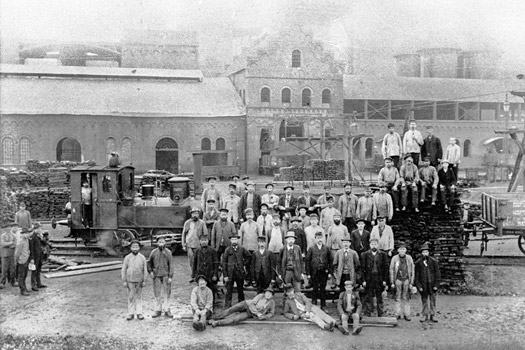
Harzer Häuser für Fachleute aus dem Harz
Ein Harzer Graf stellte das Kapital und Fachleute aus seiner Heimat für die 1855 in Betrieb genommene Henrichshütte bei Hattingen an der Ruhr.
© LWL-Industriemuseum
Kapital zurück zur Auswahl
The Henrichshütte (Ironworks) of Hattingen and the Harz Houses A Harz Count's 1853 investment in the Ruhr
“The Count Stolberg-Wernigerode intends to build eight blast furnaces aside from coke furnaces south-west of the Bruch house near Hattingen,” the Märkischen Blätter wrote on 29 March, 1854. This count from Harz was not inexperienced in the field of smelting works as metal smelting and mining had long been a tradition in his home region. However, in the 1840s there was a shortage of charcoal, so coke smelting furnaces offered a viable energy alternative. The hard coal needed for the furnaces were widely available alongside mineral ores in the Ruhr valley. There, the smeltery supervisor, Karl Roth, found an ideal location for the new smelting works. In 1853, he bought a section of the manor Bruch near Hattingen for the count and in 1855 the raw iron production began. Count Henrich zu Stolberg-Wernigerode himself never saw the iron works that had been named after him as he died in the year before its startup.
The blast furnaces and the furnaces for producing coke were built by a team put together by the Belgian expert Joseph Gobiet. A group of experienced smelters recruited from Harz began operation in 1855. Still today twelve two-story row houses from the continually expanding worker colony “Haidchen”, remind us of the workers and their families from the Harz. The houses “Harz Houses” on Henschelstraße 61–83, built in the style that was popular in their home region, are still the oldest remaining buildings from this colony.
The Henrichshütte grew over the decades into an operation whose significance carried itself well beyond the Ruhr Region. Here, at times, over 10,000 people produced coke, raw iron, and steel, as well as countless products that ranged from screw propellers to armour. Despite protests by the workers, the last blast furnace in Hattingen stopped production in 1987. This coke furnace which dates back from 1939 is the oldest preserved furnace in the Ruhr Region. With its auxiliary systems, including a large furnace blast hall from the 1890s, it forms the LWL Industrial Museum, which was opened in the year 2000. Steel manufacturing plants and other processing on the property had to make way for industrial and landscape parks. Of the few remaining buildings, one industrial hall is used today by the Westphalia Fire Service Museum. (KP)
Denkmale zum Impuls
Hattingen - Henrichshütte und Siedlung Haidchen
Spätestens mit dem Anblasen des ersten Hochofens stellte sich für die ... weiter
Hattingen - Henrichshütte
1854 begann der Aufbau der Henrichshütte im Ruhrtal bei Hattingen; Graf Henrich zu ... weiter
